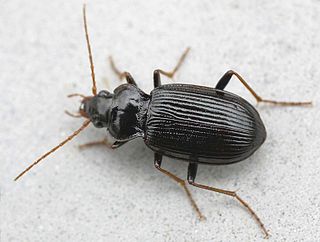
Nebria is a genus of ground beetles native to the Palearctic, the Near East and North Africa.

Nebria brevicollis is a species of ground beetle native to Europe and the Near East. In Europe, it is found in all countries and islands except the Azores, the Canary Islands, the Channel Islands, Franz Josef Land, Gibraltar, Madeira, Malta, Monaco, the North Aegean Islands, Novaya Zemlya, San Marino, the Selvagens Islands, Svalbard and Jan Mayen, and Vatican City. It has now been reported as introduced in western Oregon, U.S.A., where it has been found in highly disturbed sites as well as in native old-growth forest stands. It has also now been found in Washington State.

Nebria livida is a species of ground beetle with two subspecies:

Tetragonisca angustula is a small eusocial stingless bee found in México, Central and South America. It is known by a variety of names in different regions. A closely related species, Tetragonisca fiebrigi, occupies different areas in South America and has a slightly different coloration.
Mordellistena angustula is a species of beetle in the genus Mordellistena of the family Mordellidae. It was discovered in 1977 and is endemic to Hungary.
Nebria aetolica is a species of ground beetle in the Nebriinae subfamily that can be found in Albania, Greece, and North Macedonia.
Nebria dahlii is a species of ground beetle in the Nebriinae subfamily that can be found in Austria, all states of former Yugoslavia, and Italy.
Nebria fuscipes is a species of ground beetle in the Nebriinae subfamily that can be found in Hungary, Poland, Romania, Slovakia, and Ukraine. The species is black coloured and is 13 millimetres (0.51 in) long.
Nebria hellwigii is a species of ground beetle in the Nebriinae subfamily that can be found in Austria, Germany, and Italy.
Nebria kratteri is a species of ground beetle in the Nebriinae subfamily that can be found in Albania, Greece, Italy, and North Macedonia.
Nebria kratteri kratteri is a subspecies of ground beetle in the Nebriinae subfamily that can be found in Albania, Greece, Italy, and North Macedonia.
Nebria rubripes is a species of ground beetle in the Nebriinae subfamily that can be found in France and Spain.
Nebria tatrica is a species of ground beetle in the Nebriinae subfamily that can be found in Poland Czech Republic and Slovakia.
Nebria laticollis is a species of ground beetle in the Nebriinae subfamily that can be found in France, Italy, and Switzerland.
Nebria cordicollis is a species of black coloured ground beetle from Nebriinae subfamily that can be found in Italy and Switzerland. The species is 5 millimetres (0.20 in) long.
Demetrida angustula is a species of ground beetle in Lebiinae subfamily. It was described by Chaudoir in 1872 and is endemic to Australia.
Dinaraea angustula is a species of rove beetle in the family Staphylinidae. It is found in Europe & Northern Asia and North America.
Limnophila angustula is a species of limoniid crane fly in the family Limoniidae.






